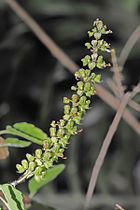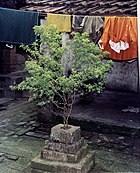Tulsi plant in Indian culture
Contents
Tulsi plant in Indian culture
Source: Wikipedia
| Discussed species | Ocimum tenuiflorum (Holy Basil) |
|---|---|
| Description | Ocimum tenuiflorum, Holy Basil (also tulsi, tulasī), is an aromatic plant in the family Lamiaceae which is native throughout the Old World tropics and widespread as a cultivated plant and an escaped weed.[1]. Tulsi is cultivated for religious and medicinal purposes, and for its essential oil. It is widely known across South Asia as a medicinal plant and an herbal tea, commonly used in Ayurveda, and has an important role within the Vaishnavite tradition of Hinduism, in which devotees perform worship involving tulsi plants or leaves. |
Use of Tulsi in Ayurveda
Tulsi has been used for thousands of years in Ayurveda for its diverse healing properties. It is mentioned in the Charaka Samhita ,[2] an ancient Ayurvedic text. Tulsi is considered to be an adaptogen,[3] balancing different processes in the body, and helpful for adapting to stress.[4] Marked by its strong aroma and astringent taste, it is regarded in Ayurveda as a kind of "elixir of life" and believed to promote longevity.[5]
Tulsi extracts are used in ayurvedic remedies for common colds, headaches, stomach disorders, inflammation, heart disease, various forms of poisoning, and malaria. Traditionally, tulsi is taken in many forms: as herbal tea, dried powder, fresh leaf, or mixed with ghee. Essential oil extracted from Karpoora tulsi is mostly used for medicinal purposes and in herbal cosmetics, and is widely used in skin preparations due to its antibacterial activity. For centuries, the dried leaves have been mixed with stored grains to repel insects.[6]
Tulsi in Hinduism
Tulsi or tulasi is a sacred plant for Hindus and is worshipped by Hindus as the avatar of goddess Lakshmi. Water mixed with the petals is given to the dying to raise their departing souls to heaven.[7] Tulsi, which is Sanskrit for "the incomparable one", is most often regarded as a consort of Krishna in the form of Lakshmi.[8][9] According to the Brahma Vaivarta Purana , tulsi is an expression of Sita.[10] There are two types of tulsi worshipped in Hinduism: "Rama tulsi" has light green leaves and is larger in size; "Shyama tulsi" has dark green leaves and is important for the worship of Hanuman.[11] Many Hindus have tulsi plants growing in front of or near their home, often in special pots. Traditionally, tulsi is planted in the center of the central courtyard of Hindu houses. It is also frequently grown next to Hanuman temples, especially in Varanasi.[12]
In the ceremony of Tulsi Vivah, tulsi is ceremonially married to Krishna annually on the eleventh day of the waxing moon or twelfth of the month of Kartika in the lunar calendar. This day also marks the end of the four-month Cāturmāsya period, which is considered inauspicious for weddings and other rituals, so the day inaugurates the annual marriage season in India. The ritual lighting of lamps each evening during Kartika includes the worship of the tulsi plant, which is held to be auspicious for the home. Vaishnavas especially follow the daily worship of tulsi during Kartika.[13]
Vaishnavas traditionally use japa malas made from tulsi stems or roots, which are an important symbol of initiation. Tulsi malas are considered to be auspicious for the wearer, and believed to put them under the protection of Hanuman. They have such a strong association with Vaishnavas, that followers of Hanuman are known as "those who bear the tulasi round the neck".[9]
Additional Media
| How to do a Tulsi Vivah | An (amateur) enthusiast's video |
|---|
References
- ^ Staples, George; Michael S. Kristiansen (1999). Ethnic Culinary Herbs. University of Hawaii Press. p. 73. ISBN 9780824820947.
- ^ NIIR Board, National Institute of Industrial Research (India) (2004). Compendium of Medicinal Plants. 2004. National Institute of Industrial Research. p. 320. ISBN 9788186623800.
- ^ Kuhn, Merrily; David Winston (2007). Winston & Kuhn's Herbal Therapy & Supplements: A Scientific and Traditional Approach. Lippincott Williams & Wilkins. p. 260. ISBN 9781582554624.
- ^ Botanical Pathways article with clinical trials details
- ^ Puri, Harbans Singh (2002). Rasayana: Ayurvedic Herbs for Longevity and Rejuvenation. CRC Press. pp. 272–280. ISBN 9780415284899.
- ^ Biswas, N. P.; Biswas, A. K.. "Evaluation of some leaf dusts as grain protectant against rice weevil Sitophilus oryzae (Linn.)". Environment and Ecology (Vol. 23) ((No. 3) 2005): pp. 485–488.
- ^ Hindu FAQ: Why do we consider Tulsi sacred?
- ^ Claus, Peter J.; Sarah Diamond, Margaret Ann Mills (2003). South Asian Folklore: An Encyclopedia. Taylor & Francis. p. 619. ISBN 9780415939195. http://books.google.com/?id=au_Vk2VYyrkC&pg=PA619.
- ^ a b Simoons, Frederick J. (1998). Plants of life, plants of death. Univ of Wisconsin Press. pp. 7–40. ISBN 9780299159047. http://books.google.com/?id=KEUAbrBoeBAC&pg=PA14.
- ^ Brahma vaivarta Purana 4.67.65
- ^ Chatterjee, Gautam (2001). Sacred Hindu Symbols. Abhinav Publications. pp. 93. ISBN 9788170173977. http://books.google.com/?id=NQ0XQHEkuIcC&pg=RA1-PA93.
- ^ Simoons, pp. 17-18.
- ^ Flood, Gavin D. (2001). The Blackwell companion to Hinduism. Wiley-Blackwell. pp. 331. ISBN 9780631215356. http://books.google.com/?id=qSfneQ0YYY8C&pg=PA331.
Comments
blog comments powered by DisqusMore notes like this
| |||||||||||||||||||||||||||||||||||||||||||||||||||||||||||||||||||||||||||||||||||||
Only 15 articles are shown in this list. A total of 64 articles in the database as of this moment. For the complete list, click on further results on the bottom right corner of the above table.
Semantic tags
- Browse all Semantic Tags associated with this page
- Find more pages and articles created by the community by clicking this link.
| Title | Tulsi plant in Indian culture | Article is on this general topic | Mythology and religion | Author | Gaurav Moghe |
|---|---|---|---|---|---|
| Specific location(s) where study was conducted | Not noted | General region where study was conducted | Not noted | State where study was conducted | Pan-India |
| Institutional affiliation | Not noted | Institution located at | Not noted | Institution based around | Not noted |
| Species Group | Plants | User ID | User:Gauravm | Page creation date | 2011/11/24 |
Share this page:

